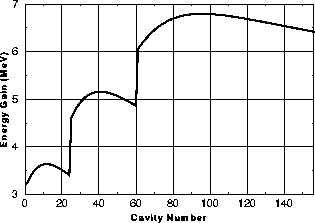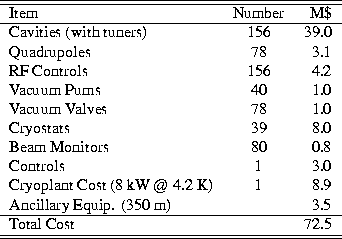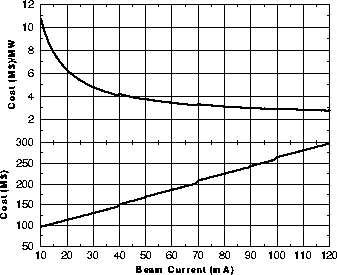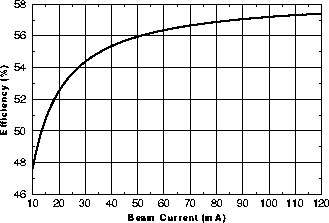C. Pagani, G. Bellomo, P. Pierini
A proposal for a 10-120 mA proton linac
employing superconducting beta-graded, CERN type, four cell
cavities at 352 MHz is presented.
The high energy part (100 MeV-1 GeV) of the machine is split
in three
A first stage of operation at 30 mA beam current is proposed,
while the upgrade of the machine to 120 mA operation
can be obtained increasing the number
of klystrons and couplers per cavity. The additional coupler
ports, up to four, will be integrated in the cavity design.
Preliminary calculations indicate that beam transport
is feasible, given the wide aperture of the 352 MHz structures.
A capital cost of less than 100 M$ at 10 mA, reaching up
to 280 M$ for the 120 mA extension, has been estimated for
the superconducting high energy section (100 MeV-1 GeV).
The high efficiency of the proposed machine, reaching 50%
at 15 mA, makes it a good candidate
for proposed nuclear waste incineration facilities
and Energy Amplifier studies[1, 2].
Our design is based mainly on the choice of a low RF
frequency for the SC linac.
A wide experience in the design, construction and operation of
352 MHz cavities and RF systems is available at CERN[3].
The 352 MHz frequency at moderate
gradient operation (around 5 MV/m) allows for large
geometrical irises and lower beam current densities.
A critical issue for such a machine will be the
control of the beam halo growth[4],
and the choice of a low frequency allows to lower both the
space charge tune depression and the ratio of the
beam (core) size with respect to the beam line aperture.
Another important issue, the future availability
of several 1.3 MW CW klystrons of the CERN LEP RF system,
that will be decommissioned before year 2000,
gives an economical impulse for the investigation of
a scheme based on the LEP 352 MHz frequency.
Moreover, we have also to take into account the experience of
several European companies for cavities
production and the cavity tooling machines already
available at the companies[3].
In our view the developement of new
In the following we present a preliminary parameter
set for the high energy part (100 MeV-1 GeV) of
the machine, as
presented to C. Rubbia in the framework of a possible INFN
collaboration to the Energy Amplifier and waste transmutation project.
The low energy part should be composed of two sections:
an RFQ[2] (up to
We have chosen to cover the energy range from
100 MeV to 1 GeV with three different families of
This choice of three energy ranges (and consequently of
three
The main characteristics of the cavities in each section
are given in Table 1.
A High Current Proton Linac
with 352 MHz SC Cavities
INFN - Sezione di Milano - LASA, Via Fratelli Cervi 201,
20090 Segrate (MI) ItalyAbstract:
![]() -graded sections, and transverse focusing
is provided via a periodic doublet array.
All the parameters, like power in the couplers and accelerating
fields in the cavities, are within the state of the art,
achieved in operating machines.
-graded sections, and transverse focusing
is provided via a periodic doublet array.
All the parameters, like power in the couplers and accelerating
fields in the cavities, are within the state of the art,
achieved in operating machines.
Choice of the 352 MHz Frequency
![]() -graded
structures[5, 2], with up to four coupler ports,
at 352 MHz could allow to reach a
beam current of 120 mA employing present technological RF
components (simply by incrementing the number of klystrons
and couplers/cavity, limiting the power per coupler to approximately
200 kW).
-graded
structures[5, 2], with up to four coupler ports,
at 352 MHz could allow to reach a
beam current of 120 mA employing present technological RF
components (simply by incrementing the number of klystrons
and couplers/cavity, limiting the power per coupler to approximately
200 kW).
![]() 7 MeV) and
a conventional DTL linac (up to
7 MeV) and
a conventional DTL linac (up to ![]() 100 MeV).
This design has been recently included as the
candidate for the high energy accelerator section
of the Energy Amplifier proposal[6],
and work is in progress for a full optimization of
the optics and for the development of the RF cavities.
100 MeV).
This design has been recently included as the
candidate for the high energy accelerator section
of the Energy Amplifier proposal[6],
and work is in progress for a full optimization of
the optics and for the development of the RF cavities.
The -graded structures for the high energy section
![]() -graded
four cell cavities at 352 MHz, with cell length defined as
-graded
four cell cavities at 352 MHz, with cell length defined as
![]() .
Four cell cavities have been chosen in order to reduce the
number of cavities and the
physical structure length, that has to include cutoff tubes,
coupler and HOM ports.
.
Four cell cavities have been chosen in order to reduce the
number of cavities and the
physical structure length, that has to include cutoff tubes,
coupler and HOM ports.
![]() values for the different sections)
allows to keep the transit time
factor of a particle in each cavity
always greater than 0.9, along the whole machine.
values for the different sections)
allows to keep the transit time
factor of a particle in each cavity
always greater than 0.9, along the whole machine.

Table 1: Energy range, design ![]() ,
active length and length of the focussing period, for the
three families of 4 cell cavities.
,
active length and length of the focussing period, for the
three families of 4 cell cavities.
The energy gain in each cavity is given by:
![]()
where ![]() is the active cavity length
(in Table 1),
is the active cavity length
(in Table 1),
![]() is the accelerating field in the cavity,
is the accelerating field in the cavity,
![]() is the transit time factor of the cavity,
depending on the design
is the transit time factor of the cavity,
depending on the design ![]() and the actual beam
and the actual beam ![]() ,
and
,
and ![]() is the operating RF phase.
is the operating RF phase.
In our design, considering the requirement of phase stability,
we have chosen ![]() , and g>0.9 all over
the machine.
The role of the transit time factor g can be seen
in Figure 1, where we plot the
energy gain of each cavity along the machine. Here we
chose a constant
, and g>0.9 all over
the machine.
The role of the transit time factor g can be seen
in Figure 1, where we plot the
energy gain of each cavity along the machine. Here we
chose a constant ![]() in each section
(the values are given in Table 2); as an
alternative approach one can individually set the cavity
gradients to provide a constant energy gain in the sections.
in each section
(the values are given in Table 2); as an
alternative approach one can individually set the cavity
gradients to provide a constant energy gain in the sections.

Figure 1: Energy gain along the three linac sections, as a function of
the cavity number, keeping the nominal accelerating
gradient fixed in each section (see text for details).
The basic accelerating cell of each linac section consists of one cryomodule containing four cavities, transverse focusing is provided by quadrupole doublets every cryomodule.
The focusing structure is a FIDA cell, where the beam acceleration is provided by four RF cavities, in one cryomodule, between successive quadrupole doublets, as seen in Figure 2. The possible use of quadrupole triplets to allow for ``rounder'' beams will also be considered.

Figure 2: Focusing structure of the linac.
The three sections of the linac have different cell lengths. The active cavity length and the corresponding lattice periodicity in the three sections are indicated in Table 1.
The quadrupole integrated field Gl ranges from 1 to 3.5 T along the machine, hence it is possible to place warm normal conducting quadrupoles between the cryomodules.
For this reference design the zero current maximal
phase advance per cell has been set to
90 ![]() , although a value close to 60
, although a value close to 60 ![]() or 72
or 72 ![]() should be more appropriate. In the first unit
of the first section there is a strong longitudinal phase
advance and a reduction of
should be more appropriate. In the first unit
of the first section there is a strong longitudinal phase
advance and a reduction of ![]() will be investigated.
will be investigated.
Preliminary calculations with the linear space charge code TRACE-3D[7] in the current range of 10-120 mA show that beam transport with a beam radius/aperture ratio in the range 10-50 along the machine is possible.
In Table 2 we report the main characteristics of the three sections of the high energy part of the linac, including RF power distribution. The maximum RF power in the couplers is approximately 200 kW, the current upgrade would require the insertion of additional couplers (up to four) in each cavity. The four coupler ports should be integrated from the beginning in the cavity design.
A total of 156 cavities and 350 m of physical length are required for the three sections of the superconducting linac, in this reference design. These two numbers could slightly increase in the final design, in order to: decrease the cavity gradient, employ quadrupole triplets focusing, include beam diagnostic elements inside the cryomodules or matching elements between sections.
The capital cost of the superconducting linac, excluding the RF power costs, is approximately 72.5 M$, and the cost breakdown is indicated in Table 3.

Table 3: Capital cost of the SC linac.

Figure 3: Lower curve: Linac total capital cost (in M$, including RF system).
Upper curve: Total cost per MW of beam power vs. beam current (mA).
Assuming a klystron efficiency of 58%, a refrigeration power of approximately 2.5 MW and a contingency power of 1 MW dedicated to the ancillary components of the linac, the overall efficiency of the machine as a function of the beam current is presented in Figure 4. Note that 50% plug efficiency is reached at 15 mA operation. The operation at the full 120 mA current would allow to reach nearly the nominal klystron efficiency.

Figure 4: Overall linac plug efficiency vs. beam current (mA)
A preliminary study for a low frequency, high current
superconducting proton linac
for nuclear waste incineration
and energy amplifier
applications has been proposed.
The machine operates at the 352 MHz of the LEP RF system
with three sections of ![]() -graded superconducting cavities.
-graded superconducting cavities.
Preliminary calculations indicate that beam transport at high current is possible, and further studies to address cavity design, both from the electromagnetic and the engineering point of view, and beam halo formation are in the starting phase.
The choice of the RF frequency and of the machine parameters provides a very good plug efficiency at high beam current, a crucial issue for the proposed applications.
We are grateful to Carlo Rubbia who stimulated this work.